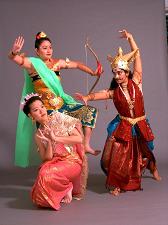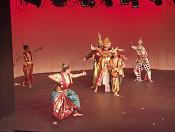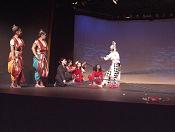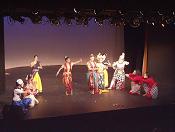Contribute
| MIT Stages Dance Fusion |
Gayathri Srinivasan
10/01/2004
MIT Students presented the Indian mythologic epic 'Ramayana' on September 26th at Little Kresge Auditorium. What was different about this concert was that it combined the story telling techniques of Javanese puppetry, and classical dance from Bali (Kecak), India (Bharatanatyam) and Thailand (Khon).
The dance drama began with the staging of the male krauncha bird courting its beloved. Oblivious were the birds to the presence of the wicked hunter who was waiting for the right moment. The hunter kills the male bird leaving the female bird in agony over losing her beloved. The author of Ramayana, Valmiki, saw this happen and felt the pain of the female bird in grief and cursed the hunter. The curse was uttered as a verse and this made Valmiki realise his innate gift for poetry. He recalled the dream where he had been instructed to write the story of Rama; which was how Ramayana came to be.
The beginning of Ramayana according the Thai mythology wherein the demon Bhasmasura was creating havoc in the universe was depicted next. Bhasmasura had the power to turn anything he pointed to ashes. The Gods decided to kill Bhasmasura to put an end to all the misery caused by him. Lord Vishnu took the form of a beautiful maiden and lured Bhasmasura and beguiled him into turning himself to ashes. Bhasmasura in his last breath told Lord Vishnu that he had been tricked and had not been given a fair chance. Lord Vishnu told him that he would have a fair chance when he would take the form of mortal human Rama and Bhasmasura the form of the powerful Ravana (the Ten-headed Demon).
The Javanese puppetry, although not a dance rendition, was presented with great appeal to the audience. It had excellent narration and had some humorous elements in it too.
In the last scene of the show depicted the war between Rama and his troupe of monkey warriors with Ravana and his powerful army of demons. This scene brought together all the dance forms on stage. This probably would have been most challenging to choreograph but was done beautifully. The dance forms melded very well into one another. The crossing of the ocean to reach Lanka, the abode of Ravana, was rendered with perfection using appropriate lighting and stage props. The scene was cleverly choreographed such that it showed Ravana using his magical powers to appear in three forms. This brought out Ravanas from all three troupes on stage.
The dance drama portrays the detailed Ramayana in 90 minutes. The beauty of the show was that it brought out the essence of Ramayana in such a short time. Although not all the details of the original epic were depicted, the acts enacted by the three different dance troupes flowed from one to the next gracefully. The costumes chosen by the dancers depicted the characters very well. The lighting for the show and the stage props and backdrops were excellent. The choice of music was splendid although the mixing could have been better in a few scenes.
On the whole the dance drama was a treat to watch. I would recommend readers with and interest in the performing arts to make it a point to see this show the next time it is performed. A lot of energy, enthusiasm and effort went into putting it together and all the hard work paid off throughout the performance. The dancers should think of continuing to refine the choreography and performing it many more times.
You may also access this article through our web-site http://www.lokvani.com/



